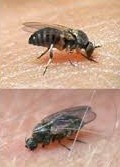
Brought to you by WBIW News and Network Indiana
Last updated on Tuesday, May 29, 2018
(UNDATED) - Warm summer temperatures allow residents to enjoy outdoor activities and events, but those activities have brought many in contact with the biting insect - the buffalo gnat.

Buffalo gnats, also known as "black flies" or "turkey gnats", are about 1/16th to 1/8th inch in size and cause often painful bites and resultant swelling in humans, livestock, poultry, and wildlife. Although not known to cause disease in human victims, their bites can cause various reactions in both human and animals ranging from small punctures to golf-ball sized swelling.
Reactions to buffalo gnat bites are known as "black fly fever" and may include headaches, nausea, fever, and swollen lymph nodes. In animals the transmission of several disease agents does occur, none of which pose a threat to humans.
Buffalo gnat swarms are capable of severely impacting human activities during parts of the year, especially in late spring or early summer in Indiana. In 2018 some state parks in Arkansas have already been shut down due to gnat swarms, and the deaths of cattle due to swarm effects have also been reported in that state.
For individuals going into the outdoors during swarming season, there are few options to reduce their impacts. Adults can fly up to ten miles, and are believed to be attracted to carbon dioxide, perspiration, and fragrances. Only the female flies bite as they search for blood for protein, but swarms of male gnats still are an extreme annoyance.
The gnats are usually most active just after sunrise and just before sunset, so avoid being outside at these times if possible. Large fans on patios help deter the gnats as well as wearing long-sleeved shirts, long pants, and hats with netting (to keep gnats off head and neck) help provide barriers to bites. Gnats also seem to prefer white clothing, while their least favorite color seems to be Navy blue.
Few chemicals are available to fight the buffalo gnats. Home remedy repellants, such as vanilla extract, have not been scientifically proven effective with the insects, and traditional DEET-containing repellants that deter mosquitoes are ineffective and may actually attract buffalo gnats. Permethrin-containing repellents specifically labelled for application ONLY TO CLOTHING may offer some limited protection.
Outdoor activities with these tiny winged nuisances is still possible for most folks, but the gnats definitely require a plan of attack before leaving your home.
For more information on buffalo gnats and their control, check out the free Purdue publication, "Black Flies: Biology and Public Health Risk" (E-251) at https://extension.entm.purdue.edu/publichealth/insects/blackfly.html.
1340 AM WBIW welcomes comments and suggestions by calling 812.277.1340 during normal business hours or by email at comments@wbiw.com
© Ad-Venture Media, Inc. All Rights Reserved.